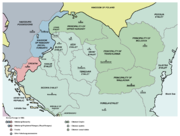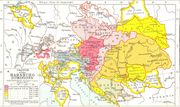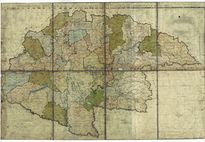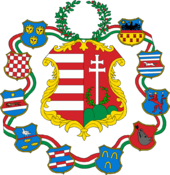مملكة المجر (1526–1867)
مملكة المجر بين 1526 و 1867 كانت، بالرغم من وجودها خارج الامبراطورية الرومانية المقدسة، جزءاً من أراضي ملكية هابسبورگ، التي أصبحت امبراطورية النمسا في 1804. بعد معركة موهاكس الأولى في 1526، أصبح البلد يُحكم من ملكين متوجين (John I و فرديناند الأول). Initially the exact territory under Habsburg rule was disputed because both rulers claimed the whole kingdom. This unsettled period lasted until 1570 when John Sigismund Zápolya (John I) abdicated as King of Hungary in الامبراطور ماكسميليان الثاني's favor.
في المراحل المبكرة، the lands that were ruled by the Habsburg Hungarian kings were regarded both as "مملكة المجر" و "المجر الملكية".[2][3][4] Royal Hungary was the symbol of the continuity of formal law[5] after the Ottoman occupation, because it could preserve its legal traditions.[6] however in general it was de facto a Habsburg province.[7] The Hungarian nobility forced Vienna to admit that Hungary was a special unit of the Habsburg lands and had to be ruled in conformity with her own special laws.[8] Although, Hungarian historiography positioned Transylvania in a direct continuity with مملكة المجر القروسطية in pursuance of the advancement of Hungarian interests.[9]
وحسب بنود معاهدة كارلوڤچه، التي أنهت الحرب التركية الكبرى في 1699، تنازل العثمانيون تقريباً عن كل المجر العثمانية. The new territories were united with the territory of Kingdom of Hungary, and, although its powers were mostly formal,[محل شك] a Diet seated in Pressburg ruled these lands.
أسفر تمردان مجريان رئيسيان مثل حرب راكوتسي للاستقلال في بداية القرن 18 والثورة المجرية 1848 عن تحولات هامة في تطور الكيان السياسي. فقد تحولت المملكة إلى ملكية ثنائية في 1867 تُعرف بإسم الامبراطورية النمساوية-المجرية.
المجر الملكية (1526–1699)
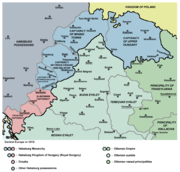
ملوك هابسبورگ
الاصلاح
مملكة المجر في أواخر الفترة الحديثة حتى 1848
القرن 18
النصف الأول من القرن 19
Enlightened absolutism ended in Hungary under Leopold's successor, Francis II (ruled 1792–1835), who developed an almost abnormal aversion to change, bringing Hungary decades of political stagnation.

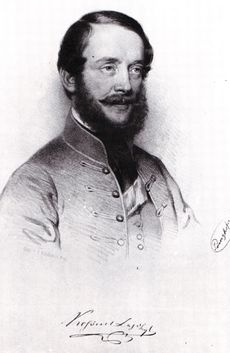
1848–1867
انظر أيضاً
الهامش
- ^ Adeleye, Gabriel G. (1999). World Dictionary of Foreign Expressions. Ed. Thomas J. Sienkewicz and James T. McDonough, Jr. Wauconda, IL: Bolchazy-Carducci Publishers, Inc. ISBN 0-86516-422-3.
- ^ Katalin Péter, Beloved Children: History of Aristocratic Childhood in Hungary in the Early Modern Age, Central European University Press, 2001, p. 22
- ^ Howell A. Lloyd, Glenn Burgess, European political thought 1450–1700: religion, law and philosophy, Yale University Press, 2007, pp. 177–189
- ^ Július Bartl, Slovak History: Chronology & Lexicon, Bolchazy-Carducci Publishers, 2002, p. 60
- ^ Lajos Besenyei, Géza Érszegi, Maurizio Pedrazza Gorlero, De bulla aurea Andreae II regis Hungariae, 1222, Valdonega, 1999, p. 222
- ^ Hajdú, Zoltán, DISCUSSION PAPERS No. 44, Carpathian Basin and the Development of the Hungarian Landscape Theory Until 1948, CENTRE FOR REGIONAL STUDIES OF HUNGARIAN ACADEMY OF SCIENCES, p. 10
- ^ Raphael Patai The Jews of Hungary: History, Culture, Psychology, Wayne State University Press, 1996, p. 153
- ^ Peter F. Sugar, Péter Hanák, A History of Hungary, Indiana University Press, 1994, p. 91
- ^ István Keul, Early Modern Religious Communities in East-Central Europe: Ethnic Diversity, Denominational Plurality, and Corporative Politics in the Principality of Transylvania (1526-1691), Brill, 2009, p. 253
- Pages using infobox country with unknown parameters
- Portal-inline template with redlinked portals
- Pages with empty portal template
- مقالات ذات عبارات محل شك
- Articles with hatnote templates targeting a nonexistent page
- Unclassified articles missing geocoordinate data
- All articles needing coordinates
- مملكة المجر
- Hungary under Habsburg rule
- Croatia under Habsburg rule
- Habsburg period in the history of Slovakia
- بلدان سابقة في اوروبا
- ممالك سابقة
- Early Modern history of Hungary
- Modern history of Hungary
- تأسيسات عقد 1530 في أوروپا
- انحلالات 1867 في أوروپا
- القرن 16 في المجر
- القرن 17 في المجر
- القرن 18 في المجر
- القرن 19 في المجر




